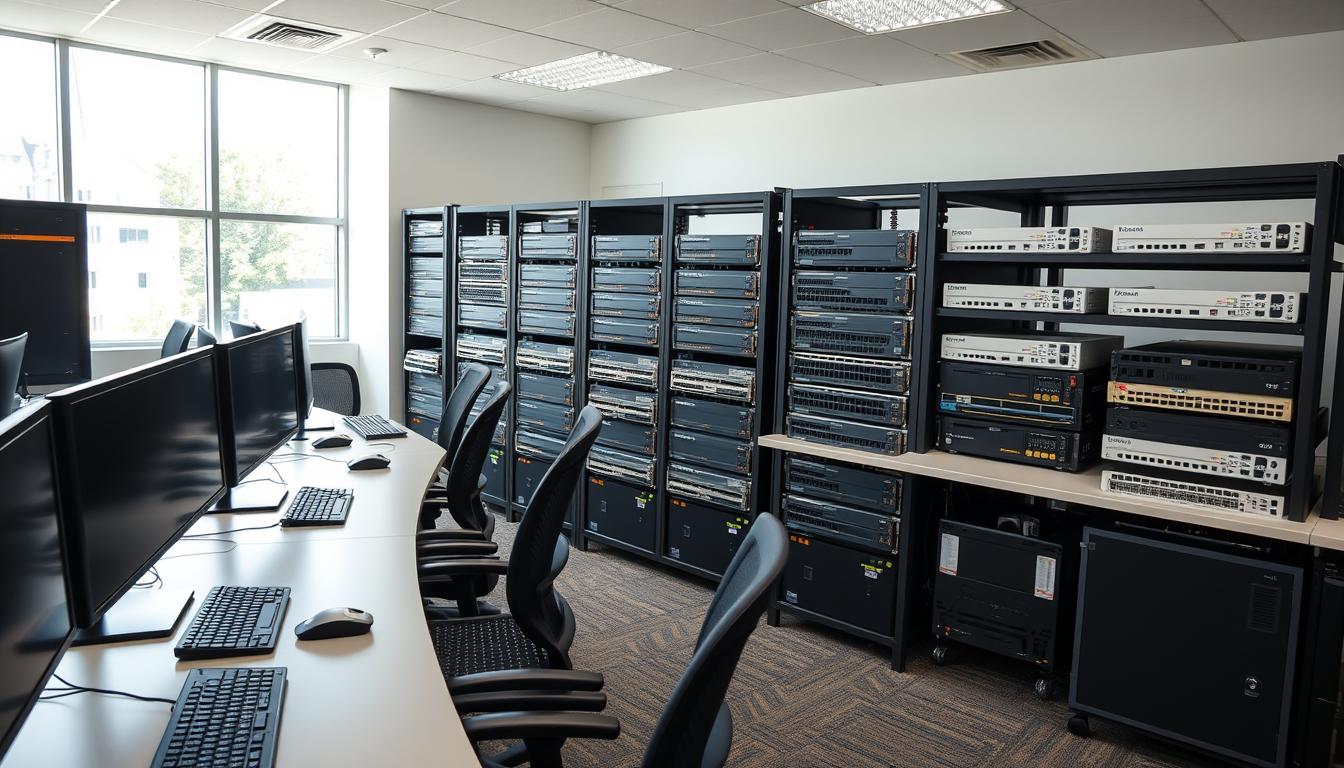Imagine sitting across from a colleague at your local coffee shop, steam rising from mugs as you swap stories about configuring routers under tight deadlines. You mention how overwhelming it feels to keep up with evolving technology while preparing for certifications. Sound familiar? With over 90% of enterprises relying on complex area networks, the demand for skilled professionals in this field has never been higher.
Salaries for roles like engineer or systems specialist average $75,283 nationally—nearly double the U.S. median wage. But here’s the catch: employers want more than theoretical knowledge. They crave hands-on experience with tools like Cisco Packet Tracer and mastery of routing protocols. That’s where structured programs from IBM, Microsoft, and Google Cloud Fundamentals shine, blending labs with real-world simulations.
I’ll never forget the first time I configured a VLAN during a late-night lab session—the mix of frustration and triumph taught me more than any textbook. This guide unpacks how to build skills needed to thrive in wide area and local network environments. We’ll explore why cisco certified credentials like CCNA act as career accelerators and how to avoid common pitfalls faced by newcomers.
Key Takeaways
- High-demand roles in this industry offer salaries up to 131% above national averages in tech hubs
- Hands-on practice with tools like GNS3 is critical for mastering real-world technology challenges
- Certifications from Cisco and CompTIA validate your knowledge to employers
- 87% of hiring managers prioritize candidates with both credentials and practical experience
- Affordable training options exist through platforms like Udemy and Cisco Netacad
Now, let’s examine the roadblocks even sharp professionals face when entering this competitive career path—and how to overcome them.
Navigating the Challenges: Opening Your Network Administration Journey
There’s a moment every IT pro faces—when textbook solutions fall short, and real-world chaos takes over. Why does configuring a VLAN in a lab feel different than during a midnight outage? How do you translate routing protocols into actual problem-solving when servers crash?
Why You Need Real-World Insights Over Pure Theory
Can memorizing OSI layers help when a phishing attack paralyzes your system? Courses from Cisco and Google Cloud teach concepts, but 83% of new hires report feeling unprepared for their first firewall emergency. That’s where sensory-rich practice matters—like smelling burnt router components during hands-on repairs.
Consider these daily hurdles:
| Challenge | Theory Approach | Real-World Fix |
|---|---|---|
| Security breach | Memorize encryption types | Use Wireshark to trace suspicious packets |
| Connectivity drop | Study IP addressing | Configure redundant links with GNS3 |
| Slow performance | Understand bandwidth limits | Analyze traffic patterns via SolarWinds |
Sensory-Rich Coffee Moments and Practical Experiences
Ever solved a DNS issue while tasting bitter espresso? Coursera Project Network participants often share breakthroughs during casual meetups. One engineer discovered a subnetting shortcut while sketching diagrams on a coffee-stained napkin.
Mentorship accelerates growth. Platforms like Cisco’s NetAcad connect learners with pros who’ve handled actual data breaches. As one admin jokes: “My best firewall rules came from post-outage pizza debates.”
Your turn: What everyday moments could spark your next troubleshooting win?
Building Your Foundation with Network Administrator Training
Did you know professionals with certifications earn 30% more on average than their uncertified peers? Start by mastering core computer concepts like routing protocols and configuration management. Top programs from Google Cloud and IBM blend interactive labs with industry-aligned curricula—exactly what hiring managers want to see on your resume.

Essential Skills for Tomorrow’s Tech Landscape
You’ll need hands-on experience with tools like Cisco Packet Tracer. Think subnetting, firewall setups, and troubleshooting latency issues. The U.S. Bureau of Labor Statistics notes 3% fewer roles by 2033, but cloud migration creates new opportunities for specialists with updated systems expertise.
Compare these key credentials:
| Certification | Skills Validated | Salary Boost |
|---|---|---|
| CCNA | Network design, security | +$14,200 |
| CompTIA Network+ | Troubleshooting, cabling | +$9,800 |
| Google Cloud | Hybrid infrastructure | +$18,500 |
How Certifications Open Doors
Microsoft’s courses teach real-world scenarios—like restoring data after ransomware attacks. One NVIDIA-trained engineer shared: “My CCNA helped me transition from help desk to security analyst in 9 months.” Platforms like Coursera offer affordable paths to these credentials.
Pair classroom learning with virtual labs. Practice configuring VLANs or diagnosing DNS errors. As roles evolve, this mix of theory and action keeps your computer skills sharp and employers interested.
From Classroom to Real Life: Integrating Technical Skills with Hands-On Experience
Picture this: You’re configuring a firewall while monitoring real-time traffic spikes during peak business hours. Textbook diagrams can’t capture the adrenaline of keeping computer systems secure under pressure. That’s where classroom concepts transform into career-ready expertise.

Bridging Academic Knowledge with Industry Demands
Learning subnetting is like mastering chess—the real game begins when you apply strategies to live wide area networks. Microsoft’s “Introduction to Secure Networking” course mirrors this shift, tasking students with containing simulated ransomware attacks using actual enterprise software.
| Academic Concept | Real-World Application | Tools Used |
|---|---|---|
| Encryption Protocols | Securing remote work VPNs | OpenVPN, WireGuard |
| Traffic Analysis | Optimizing e-commerce site speed | SolarWinds, PRTG |
| IP Addressing | Troubleshooting IoT device conflicts | Wireshark, Angry IP Scanner |
Leveraging Data for Practical Wins
When Coursera Project Network participants configure test environments, they often smell overheated servers before seeing error logs—a sensory clue textbooks omit. These experiences build the reflexes needed to become network administrator professionals who thrive in crises.
Consider these insights from the field:
- 86% of companies upgraded their monitoring software post-pandemic
- Specialists who master network performance tools earn 22% more than peers
- Hybrid cloud setups require 53% more troubleshooting than traditional area setups
Your next career leap starts when textbook diagrams evolve into muscle memory. Ready to turn configurations into solutions?
Unlocking Career Opportunities: Advancing from the Help Desk to Professional Roles
Ever felt like your career’s stuck on pause while the tech world races ahead? You’re not alone. The U.S. Bureau of Labor Statistics projects 3% growth for systems roles through 2033—but cloud migration and security demands create new paths for those ready to level up.
Climbing the Ladder: Junior to Lead
Most pros start at help desks fixing password resets. But with focused skill-building, you could be managing wide area networks or leading incident response teams within 3-5 years. Look at this progression:
| Starting Role | Key Skills Added | Next-Level Position |
|---|---|---|
| Help Desk Tech | Basic troubleshooting, ticket systems | Systems Analyst |
| IT Support Specialist | Firewall configurations, VLAN setups | Security Engineer |
| Network Technician | Cloud integration, automation scripts | DevOps Specialist ($107k avg) |
Your Network Is Your Net Worth
Landing advanced roles often hinges on who you know. Join Cisco’s online forums or local Meetup groups focused on security trends. One AWS-certified pro shared: “A 10-minute chat at a conference led to my first cloud architect gig.”
Mentors matter too. Platforms like LinkedIn Learning connect you with leaders who’ve navigated similar jumps—like moving from resetting passwords to managing zero-trust architectures. Pair these relationships with certs like CCNA or CompTIA Security+ to show you’re ready for bigger challenges.
Ready to turn today’s frustrations into tomorrow’s promotions? Let’s explore how to cement these gains in our final wrap-up.
Conclusion
That final sip of cold coffee tastes like victory when you’ve just optimized a client’s communication infrastructure. Remember: certifications like CCNA aren’t just badges—they’re proof you can troubleshoot routers while deadlines loom. With roles in this field offering salaries 30% above average, your journey from theory to practice matters now more than ever.
Blend labs with live scenarios. Master hardware configurations through platforms like Cisco NetAcad. Join communities where seasoned professionals share war stories about securing switches during cyberattacks. One sysadmin told me: “My career took off when I stopped memorizing textbooks and started building redundant systems.”
Picture this: You’re sketching firewall rules on a café napkin, steam from your latte curling around breakthrough ideas. That’s where growth happens—in messy, caffeinated moments that textbooks can’t capture. Ready to become network-savvy? Start today: configure that first VLAN, enroll in a cloud fundamentals course, or message a mentor. Your next career leap is brewing.
FAQ
How can hands-on training boost your career in tech roles?
What certifications should you prioritize for career growth?
Why is professional networking critical in this field?
How do junior roles prepare you for advanced positions?
What’s the best way to stay updated with industry trends?
Can soft skills impact your success as a professional?
Source Links
- CCNA Training and Certification
- Resources for learning Network Administration
- Here’s how you can overcome challenges as a beginner in Network Administration.
- How to Launch a Career in Network Administration – Intellectual Point
- What do you do if you’re a beginner in Network Administration and facing common challenges?
- Only the essentials: How to become a Network Administrator
- Network Administrator Training
- Computer & Network Systems Administration
- What is a Network Administrator? Skills, Duties, and Career Opportunities
- Network Administration – Fayetteville Technical Community College
- 9 Steps to Advance Your IT Career Past the Help Desk
- Become a Computer Network Administrator | CW
- What Is a Network Administrator? A Career Guide
- How to Become A Computer Network Administrator





